One special DASARA recalled
CASCADE OF COMPASSION – THE STORY OF THE SRI SATHYA SAI DRINKING WATER PROJECT FOR THE ANANTAPUR DISTRICT
by Prof. G. Venkataraman
Part 1
| |
Loving
Sai Ram and greetings from Prasanthi Nilayam. It’s been a long time
since I did a regular musings talk; there have been many reasons for
this. There is no time to go into all those details but let me just say
I have been quiet busy and I hope to resume my regular broadcasts
shortly. Meanwhile I am doing this talk for a very special reason.
As
many of you are aware the Dasara celebration just went by. There is
plenty of folklore and there are many stories about the meaning of this
festival, its significance and so on but I shall skip all that now.
There is a reason why I am making a reference to Dasara and that has a
bit of important history that all of us must know. Specifically I wish
to recall today the Dasara of 1997; that year this festival fell on
October 11 and something very important happened that afternoon. What
was that? That is what I am going to tell you now.
Recollecting Those Divine Dasaras
Back then the routine on Dasara day used to be as follows. In the morning we would all assemble in the Poorna Chandra Hall for the conclusion of the yagnam, the grand conclusion I should say when the Poornahuti (final offerings to the sacred fire) would be performed in Swami’s divine presence. Oh, it was wonderful, glorious!
      |
| Baba
can be seen here seated on the dais during the Poornahuti function.
Below is a video of a Poornahuti from a more recent year View Video: http://player.vimeo.com/video/30539692 |
| |
After the Poornahuti all go out in a procession, sometimes in those days it used to be led by Sai Gita (Baba's devotee-elephant). They would go to River Chitravathi to bring some water which would take almost an hour. During that time Swami would give a divine discourse and by the time He ended the priests would also be marching in. I don’t know how they timed it but it happened that way almost always. And once the priest came they would offer the river water ceremoniously to Swami, He would bless it and then would start the exciting procedure of sprinkling holy water on all the devotees. The water would be poured out from the pot into a big silver bowl and Swami would go around sprinkling it with a big sprinkler. And He would go up and down the hall and people would lean forward, waiting and craning their necks for some drops of holy water to fall on them; some got really drenched and they were so happy. Of course, Swami also was fully wet and the interesting thing is that the more He sprinkled the more happy He would become, and He would go all along the aisle and different corners of the hall to make sure that not even an ant or a mosquito is left.
      |
| At the end of the yagnam, Bhagawan would walk around the entire auditorium sprinkling the holy water on all assembled. Seen here are scenes of one such occasion |
      |
      |       | |
| This
act of sprinkling sanctified water is referred to as prokshanam and It
is done to purify a place or a person. Every year people gathered would yearn to receive this benediction from Baba at the end of the yagna. Below is a video of that scene taken during Dasara2002 | ||
And
that would not be all, He would go outside the hall because there
would be many people waiting on both sides of the auditorium and He
would shower His blessings and grace by sprinkling holy water on all of
them. By the time it all ended it would be almost 1 p.m. and after
that you would normally think it would be a relaxed afternoon, often it
is but on this particular Dasara day there was a hectic schedule in
the afternoon also. It started around 3.00 p.m. and what was that
function about? That’s what this talk is about.
View Video: http://player.vimeo.com/video/30539942
| |
Let
me first do a bit of a flashback by taking you back from 1997 to 1994
when it all started. On the afternoon of November 22 that year there
was a function in Poorna Chandra Hall. The purpose of this was to
honour Dr. Venugopal; he’s the surgeon who performed the first heart
operation on November 22, 1991, the day the hospital was inaugurated.
A suggestion to the Government that Turned into a Mammoth Initiative
Three years had passed, Dr. Venugopal had done yeoman service to Swami’s hospital and Bhagawan wanted to bless and honour him in public. That is why this function was arranged. The then Prime Minister of India, Mr. P.V. Narasimha Rao (who by the way was the person who inaugurated the hospital three years earlier) was invited to be present on this occasion as the chief guest. Dr. Venugopal was duly honoured and after that the Prime Minister gave a speech, which was of course normal.
Three years had passed, Dr. Venugopal had done yeoman service to Swami’s hospital and Bhagawan wanted to bless and honour him in public. That is why this function was arranged. The then Prime Minister of India, Mr. P.V. Narasimha Rao (who by the way was the person who inaugurated the hospital three years earlier) was invited to be present on this occasion as the chief guest. Dr. Venugopal was duly honoured and after that the Prime Minister gave a speech, which was of course normal.
      |
| Dr.
Venugopal who performed the first heart surgery in the SSSIHMS is
being felicitated by the then PM of India, Mr. P. V. Narasimha Rao,
November 22 1994. The function was held in the Poorna Chandra Auditorium. |
      |
      |
| It was the third anniversary of the Super Speciality Hospital in Puttaparthi and it was during the discourse delivered on this occasion, that Baba asked the Government to take steps to solve the problems of the Rayalaseema area. |
Finally
came Swami’s discourse wherein He spoke about the hospital, the
contributions of Dr. Venugopal and so on, but then suddenly He injected
a new note. Turning to the Prime Minister Swami said: “This area is an arid region.” An arid region means a place which is almost like a desert; which gets very little rainfall. So Swami stated: “This
region, Rayalaseema has been suffering without proper drinking water
facilities for a long time; nobody has done anything about it, its time
that somebody did something.” And then Swami said very significantly: “If
the government comes forward to start a project, we in the Sri Sathya
Sai Central Trust would not be far behind and are ready to extend any
help that the government may want.” Now that was the direct
appeal to the Prime Minister. After that the function was over, the
Prime Minister left and now the question is 'What happened?'
Well,
in Delhi (the Capital of India) nothing happened but over here Swami
was waiting for a response. After November and December, January too
came and went. Same with February and March but not a word from Delhi.
Swami became seemingly impatient; this was 1995. So what did He do? He
called the members of the SSS Central Trust and gave them orders - I
would like to call it 'marching orders' because it was given in March.
So what did Swami say? Simply this: “Give
safe drinking water to as many people as possible, in as many villages
of Anantapur district as possible and in such a manner that they get
water throughout the year.” The last phrase 'throughout the year' is very important.
So there are two points here: safe drinking water and perennial availability all the year through. And then He added: “Do it as quickly as possible; do not worry about the cost. The job must be done, that’s all.” Those were the orders.
The
members of the Central Trust were definitely stunned at least to a
certain extent because there were cash flow issues but then Swami’s
orders are orders. So promptly the missionaries swung into action and
the first person who was sent for was Mr. Kondal Rao. He was at that
time a chief engineer in charge of irrigation and water works in the
government of Andhra Pradesh. Swami also sent for Mr. A. Ramakrishna
who at that time worked for Larsen & Toubro (this company had just
then completed the construction of the Sai Kulwant Hall, at least parts
of it). So these two people were called and told that a drinking water
project had to be done for the Anantapur Districts, and it had to
start almost immediately. “Go ahead, look around and give Me a plan.”
That was Swami’s order.
      |
| Baba seen with A. Ramakrishna (to His right) and Kondal Rao (to the left) who together played a leading role in the execution of not only the Anantapur Drinking Water Scheme but many others. |
Then
Mr. Kondal Rao and Mr. Ramakrishna went and met the state government
of Andhra Pradesh, after all their permission was needed as the land
belonged to them. They also started scouting around for sources of
water. Here we must pay careful attention to what Swami had said: “Safe
drinking water.” What’s the meaning of this? Normally till that time
people were drawing water from the ground for purposes of drinking.
Well, that’s what people do in most places but in Anantapur district
there was a problem with ground water because of the presence of
excessive fluorine.
Now
anyone who knows chemistry would know that fluorine is a chemical
element rather like chlorine. While chlorine is often used to purify
water, fluorine is also needed in water to a small extent but excess of
it can be very troublesome. Why? Firstly, it produces what is caused
'dental fluorosis' wherein the teeth get deformed; they become black
and there are all sorts of problems. But more dangerous is 'skeletal
fluorosis' wherein the bones get horribly deformed. It is really
frightening to see these people as all their life they walk with
completely bent bones; walking is torture and some people can’t even
walk, they have to drag themselves. Thirdly, it causes rheumatic
arthritis.
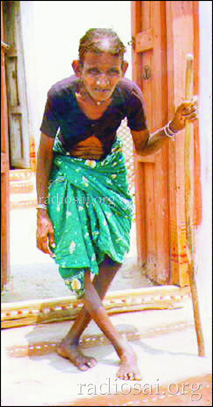 |       | ||
| Seen here are pictures showing cases of severe skeletal fluorosis, a condition very common in the Anantapur District prior Baba's drinking water scheme. | |||
      | |
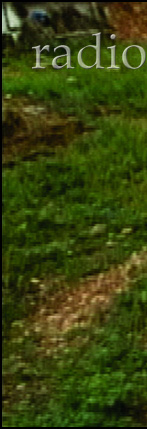 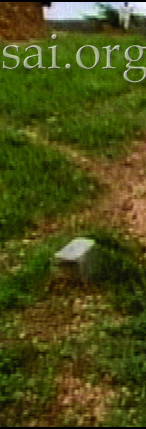  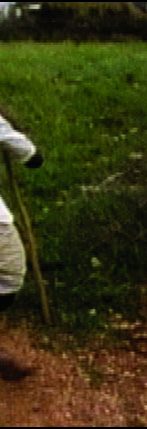 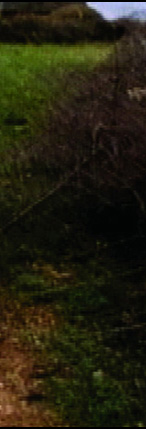 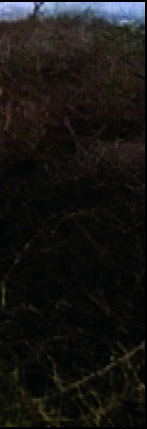 |
All
these problems are widely prevalent in the district of Anantapur and
Swami was aware of that. That is why He insisted on safe drinking
water, which in simple words means, water without fluorine.
sourced:
sourced:
CASCADE OF COMPASSION – THE STORY OF THE SRI SATHYA SAI DRINKING WATER PROJECT FOR THE ANANTAPUR DISTRICT
by Prof. G. Venkataraman
by Prof. G. Venkataraman
Part 2
| |
So
Mr. Ramakrishna and Mr. Kondal Rao went around all over the district
and tried to locate places where they could get water with very little
fluorine. But how to get this water? Rain water, as it comes from
above, doesn’t have any fluorine but there is so little rain in this
region. So what they did was - they went around looking for places
where they could draw rain water. One may say rain water is available
only when there is rain, that's true, but rain water also flows through
rivers and this water can be dammed. From the dams there can be canals
and so on and so forth. Even if there is no rain there is subsoil
water in the riverbeds. So they went around looking for irrigation dams
and canals, and riverbeds where there was good subsoil water. And it
is around these 'head sources' that they planned the drinking water
projects.
The Modus Operandi of the Divine Magnum Opus
In
brief they adopted three strategies. Strategy number one was to draw
water from an irrigation canal and this can be done only during the
season when there is water in the canal as water is released for
irrigation only periodically not always. And when they draw water from
that canal, they pump into a huge storage tank. And from there it is
filtered and distributed. So in Scheme 1 water was drawn from an
irrigation canal, stored in a summer storage tank and then distributed
to the villages.
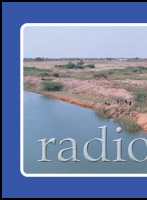 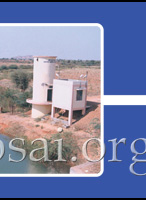  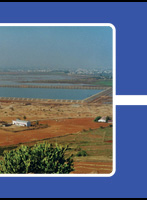  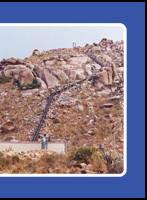 |
| River water flowing in an irrigation canal is drawn by an intake well using a pump (left) and sent through underground pipes to a huge storage tank tens of acres in area (center). Water is then pumped out, purified and then sent to a storage reservoir for distribution. (right) This is a pumping station that is sending water to a reservoir up a hill. |
In
Scheme 2 there was one small dam across a river bed and a canal system
that was called PABR (Penna Ahobilam Balancing Reservoir). They
decided that since some water is stored there, it could be drawn,
purified and distributed.
 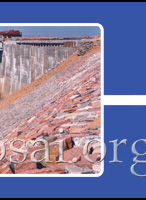 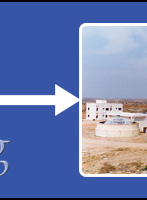 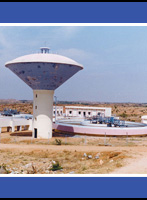 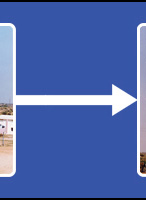  |
| Water from small dams were drawn purified and then distributed. |
In
Scheme 3 the plan was to draw water from the bed of a river.
Interestingly, we think that River Chitravathi that flows past
Puttaparthi disappears somewhere into the Bukkapatnam Tank. Actually it
goes all the way to Kadapa and joins River Penna. If we see a map we
can find this.
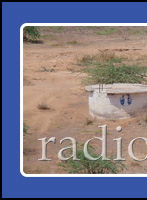 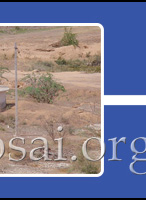 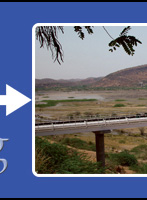 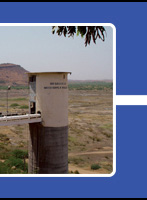 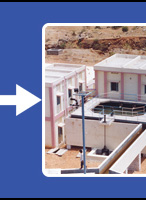  |
| Water was also drawn from river beds, purified and distributed |
So
Mr. Ramakrishna and Mr. Kondal Rao decided to sink infiltration wells
somewhere in River Chitravathi at the border of Kadapa because there
was a good supply of subsoil water which is fluorine free.
So
these were the 3 schemes based on which they decided to execute the
water project - the basic idea being to draw water from these places
and distribute it to as many as villages as possible.
However
there was another problem: The elevation in Anantapur district is not
flat as there are lots of hills and valleys, and in the North where
there is water is at a slightly lower level than the South. Therefore
to bring water from the North to the South water has to be pumped
against gravity and this was a bit of a problem as it costs energy
which automatically means more pumping stations and all sorts of
things.
 |  | |
| Relief map of Anantapur district showing the wide variations in elevation. From the map it should be clear that the south is at a higher elevation than the north. | This schematic illustrates how typically all major sources were at a lower level than the places to be served. |
Nevertheless
it had to be done as those were Swami’s orders and they decided to do
it. So they prepared a plan, submitted it to Swami and waited for His
approval.
Once the report was presented, Bhagawan approved it and said: “Go ahead and start immediately.”
So
work began at several sectors simultaneously and not as is normally
done, that is, one thing at a time. Swami did not believe in the later
philosophy - ‘If work has to be done, do it and if you can, do it in
all places simultaneously. Go ahead; I want it finished as quickly as
possible’, that's Swami's way of working.
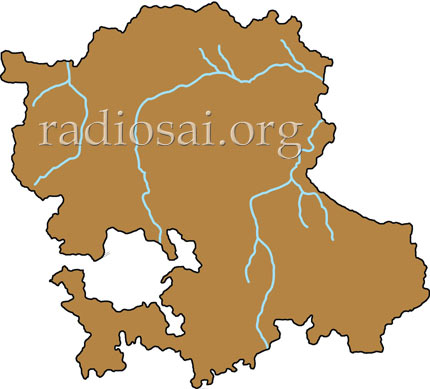 | 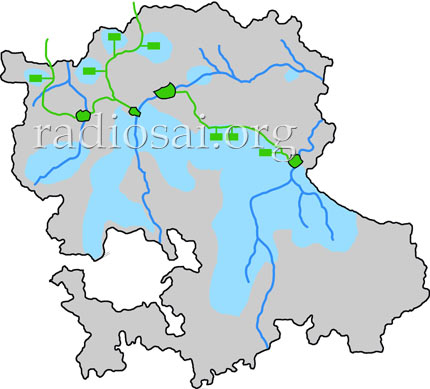 | |
| This map shows the rivers flowing through the district. These rivers are dry except during the rainy season. Most of the water tapping was done in the northern part. | The blue color in this map shows the regions served by Baba’s drinking water project for Anantapur district. |
 |  |  |  |  |  |  |  |
| Seen here are some photographs taken during the construction stage. | |||||||
 |  |  |  |  |  |  |  |
 |  |  |  |  |  |  |  |
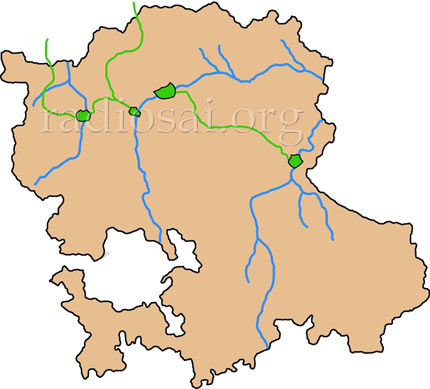 |  | |
| This map shows how the rivers have been interconnected via canals to create various reservoirs. | This map shows the location of seven summer storage tanks, each of which supplies water to villages in the neighborhood. |
 |  |  |  |  |  |  |  |
| Construction work was carried out simultaneously in different sites | |||||||
 |  |  |  |  |  |  |  |
| A summer storage tank under construction | |||||||
One
very interesting thing about Swami is He was always rather impatient
once He started a project. So much so, I used to say, Prof. Kasturi
wrote a book called ‘Loving God’ but I am going to write a book called
‘Impatient God’! I have seen a lot of that impatience as Vice
Chancellor especially.
So
once the work started, Swami wanted somebody from the Central Trust to
supervise constantly - this is something He always did. If He started a
project and gave the contract to a company He wanted somebody from His
side to see the work in progress regularly and report to Him as
frequently as possible preferably daily. Back then during the Anantapur
project Swami used to get daily reports.
Apart
from that once a week or so Mr. Ramakrishna and Mr. Kondal Rao would
come and show photographs and keep Swami abreast with the progress.
Work
progressed very fast and once Swami was so keen to see it He was
actually taken in a small plane belonging to the L&T; it took off
from the Puttaparthi airport. Swami was away for 3 hours; He flew all
over the construction sites and returned; He was very happy.
|
| |||||||||
| A overhead reservoir under construction | Baba returning to Puttaparthi after flying over the various construction sites. |
 |  |  |  |  |  |  |  |
| A water purification plant under construction. | |||||||
 |  |  |  |  |  |  |  |
| Pipe laying was an important part of the project. In all close to 2,500 kilometers of pipe were laid during the project. Seen here are picturs depicting the enormity of the task of pipe laying. | |||||||
 |  |  |  |  |  |  |  |
 |  |  |  |  |  |  |  |
 |  |  |  |  |  |  |  |
 |  |  |  |  |  |  |  |
 |  |  |  |  |  |  |  |
 |  |  |  |  |  |  |  |
The Project Unfolds in Record Time
This
is what happened from March 95. Lets now come to November of that
year. Incidentally that was the year of Swami’s 70th birthday; so it
goes back about 15 years. In November 18, 1995 Swami held a function in
the Poorna Chandra Hall; this time too Mr. P.V. Narasimha Rao was
invited as the chief guest. And what was the function about? The
inauguration of the Anantapur Summer Storage Tank; it’s a 60 acres or
so huge tank which supplied water to the Anantapur town.
      |
| The picture above shows a long shot of one of the tanks. Seen below is the panoramic view of Anantapur Summer Storage Tank which extends over sixty acres |
 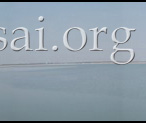 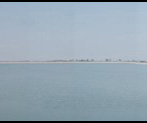 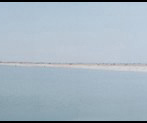 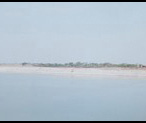 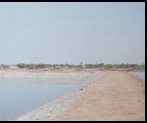 |
So
Mr. Narasimha Rao came and sitting in the Poorna Chandra Hall, he
pressed a button which was connected to the pumps in Anantapur (about
70 kilometres from Puttaparthi) and the pumps started working; water
started coming from the taps. And somebody through wireless connection
or telephone reported that the pumps have started working and water was
flowing. Everybody clapped and Swami was smiling. It happened just
nine months after He gave the order 'go'.
      |
| Pictures taken on November 18, 1995, on the occasion of the inauguration of the Anantapur Summer Storage Tanks. The inauguration was done by the then Prime Minister Mr. P.V. Narasimha Rao. A button was pressed which started the pumps in Anantapur seventy kilometers away, following which water started flowing. To mark the occasion the Prime Minister opened a small tap placed on the stage from which water flowed. |
      |
In
those nine months about 80% of the Anantapur drinking water project,
which is by the way a massive project, had been completed. In fact the
project had so many aspects to it that a lot of people got the chance
to inaugurate bits and pieces of it. While the Prime Minister got a
small piece of the action the President of India got most of it and
that happened on Swami's 70th Birthday in the Hill View Stadium in full
public view. Oh! it was a gala function! And if I remember correct
Swami was in a white robe. The President was present. Even the current
Prime Minister was there as he had come to deliver the convocation
address on the previous day. At that time Dr. Manmohan Singh (the
future Prime Minister) was the Finance Minister while Dr. Shankar Dayal
Sharma was the President of India.
      |
| On November 23, 1995, which marked the seventieth birthday of Baba, the then President of India Dr. Shankar Dayal Sharma formally inaugurated the rest of the Anantapur Drinking Water Scheme. Some residual works were left but were completed within the next four months, following which the water distribution scheme became fully operational. |
      |
For
those who are not aware, Dr. Shankar Dayal Sharma was a devotee of
Swami from a very long time and he used to come to Him regularly from
the time he was first appointed Governor of Andhra Pradesh. At that
time he had to come to Puttaparthi from Hyderabad, of course there was
no airport in those days but he did not mind driving down or coming by
train. Whatever it maybe he used to come to Him very often. Then he was
made the Vice President of India and he continued to come frequently.
Later he was made the President and the first thing he did was to go to
Tirupati, get his head shaved and promptly show up in the Poorna
Chandra Hall. It was a very sudden visit. So he was a frequent visitor
to this place and he simply was thrilled to have the opportunity to
inaugurate the entire Anantapur Drinking Water Project. Of course only
80% had been completed but then that’s more than 50%, so you can say it
was almost done.
      |
| A photograph that shows people drawing water without any difficulty or hassle. |
      |
| Every village is provided with several taps so that no family has to go a long distance to fetch water. |
      |
| A typical scene of a village served by Baba's water project |
Now
let me go to what happened afterwards. Normally after inauguration the
tempo slackens and projects sort of drag on and on, but not in Swami’s
case. He sat tight and made sure the project was completed by about
March 1996. In one year the entire drinking water project was
completed. It was a massive project and I’ll give the statistics
shortly. So what did He do afterwards? Did He hand over the project to
the government? No, He said we must test the system. So He told the
Central Trust and L&T to run this project for more than a year and
make sure that everything is working properly - not just from the
machinery and the technology side but seeing if people are getting
drinking water in their taps without any hassle; that’s very important.
“I don’t want any hassle; people have suffered enough. So make sure about this,” He said.
Therefore
L&T and the Central Trust worked out a very nice scheme for
ensuring that pumps are run properly and water is distributed everyday,
be it rainy season, summer, winter or whatever. If there were
breakdowns, they made sure repairs were undertaken immediately. So in a
sense the system was debugged shall I say, for nearly a year and a
half and when Swami was sure that everything was alright, He decided to
hand over the project to the people of the state as a gift.
But
before that He wanted to make one last thing certain, that the body
which took over and ran the Anantapur district waterworks would not be
tied down by red tape. So Swami talked to the Chief Minister and said: “We
will have a separate administrative committee that will report
directly to the Chief Minister. This committee would be presided over
by the district collector of Anantapur and would have representatives
from the Central Trust, L&T, the government and the people.”
Beneficiaries were also included, why? That was because if there are
any problems they could come and openly tell the board; they didn't
have to do it through petitions and so forth. And that was also the
reason why this committee would not be under any government department;
Swami was very particular about that. He did not spend crores of
rupees for water supply to be interrupted indefinitely due to red tape.
He did that project because He wanted to remove the sufferings of the
people and He didn’t want the sufferings to come through the backdoor
via red tape. He made sure about this institutionalisation and then
said that we will now have a formal handover ceremony. And it is that
ceremony which took place on the Dasara of 1997.
The Completed and Tested Water Supply Project Was Gifted to the People of the State
      |
| On October 11, 1997 Baba gifted the entire Anantapur Drinking Water Facility to the people of Andhra Pradesh. Justice Bhagavati, member of Baba’s Trust speaking on the occasion. |
That
function as I told you was held in the afternoon around 3.00 p.m. or
so. After the introductions and announcements, Justice Bhagawati who is
now the chairman of the Central Trust, spoke on behalf of the Trust
explaining why Swami did the project and so on and so forth. Then a
number of others spoke – Mr. Kondal Rao, Mr. Ramakrishna and also Mr.
Chakravarthi who was supervising the project from the Central Trust
side. And interestingly all of them spoke only in Telugu, and there
were no translations. Mr. Chakravarthi can converse fluently in Telugu
but giving a stage speech in proper non-colloquial Telugu is a
challenging task even for him. He therefore prepared a speech and read
it out and came through unscathed. And after that the Chief Minister of
Andhra Pradesh spoke and he did it from his heart.
      |
| Chief Minister of Andhra Pradesh, Mr. Chandra Babu Naidu accepting the facilities on behalf of the state. |
Basically
this is what he said, “All this work ought to have been done by the
government but the government failed to do it and Swami has done it.”
He openly admitted it. He was sorry about it, and also a bit ashamed,
but he was grateful to Swami.
And
Swami spoke last as always and made a very important point and that is
what I would now like to recall. He said: “All are the same to me. I
have absolutely no distinctions based on colour, creed, race, cast,
religion or nationality. Wherever it is if people are suffering I
cannot bear and I will do whatever I can to help them.” That is the
important point. He did not talk about the statistics; He did not say
2500 kilometres of pipes were laid. He left all that to the others. He
said: “I did this project because I wanted to remove the suffering of
people, no one had attempted to do it. I could not see the people in
pain, so I intervened. Now I am giving it to you people with My
blessings.”
      |
| Delivering a discourse during that occasion, Baba declared that He was always ready to help anyone in need, without consideration of caste, creed, race, religion or nationality. |
Now
at this stage I want to give you some statistics because they are very
impressive. Swami has done quiet a few water projects after the one in
Anantapur district. He did projects in Mahboobnagar, Chennai and then
in East and West Godavari. So it makes it exactly half a dozen
projects. I have talked to Mr. Ramakrishna and he said, “Of all these
projects Anantapur still continues to be one of the most complex water
projects we have done so far.”
I’ll
come to the cause last. Swami said give water to as many villages as
possible. And how many villages were covered by this project? 731! He
said give water to as many people as possible. How many people receive
the benefit of safe drinking water? About a million people! How many
summer storage tanks were there? Seven! How many infiltration wells
were sunk? 15!
      |
| (Above)
A collection well where a pump sucks out the water from all the
infiltration wells and sends it further for distribution. (Below) Water being drawn from an irrigation dam via three vertical pipes. |
      |
How
many booster stations were there? (These are stations which boosted
the water from ground level to higher level, remember water had to be
pumped from north to south against gravity.) There are 32 booster
stations. There were 6 water treatment plants where water was purified.
There were 191 overhead reservoirs or tanks whose capacity varied from
40,000 to 300,000 litres. And there were 133 ground level reservoirs
of various sizes.
      |
| A close-up view of the pump house (above).This circular tank (below) is used for precipitating out solid contaminants. This is one of the many processes involved in the purification of the water before it is distributed. |
      |
And
by the way the total cost of the project in US dollars of 1995 was 70
million. In today’s dollars it would be much more, maybe 90 million or
100 million I don’t know the extent to which dollar has become weaker.
70 million is no small amount, in fact at that point of time no private
charitable trust had executed a water project of this magnitude
anywhere in the world. That’s not all. For the first time in India,
villages that are over a 100 kilometres away from the water source got
purified water. And by the way if you have to distribute water to 731
villages it calls for a lot of pipe laying. You know how much of piping
length was there? 2,500 kilometres!
      |
| The water drawn from a dam is taken via the pipe seen above, along the wall of the dam. |
      |
 |
| This graphic is based on a photograph taken at a purifying and central distribution plant (shown in yellow above). As can be seen, a large number of villages are served. It is worthy of note that the farthest village is several tens of kilometers from the main source. Also can be seen several icons representing intermediate stages in the distribution process. |
 |  |  |  |  |  |
sourced:
CASCADE OF COMPASSION – THE STORY OF THE SRI SATHYA SAI DRINKING WATER PROJECT FOR THE ANANTAPUR DISTRICT
by Prof. G. Venkataraman
by Prof. G. Venkataraman
Part 3
The Statistics That Indicate the Undeniable Positive Impact of the Project
I
told you that Swami insisted on safe drinking water and that was
because of the fluoride problem. As I mentioned earlier, one of the
important features of Swami’s drinking water project is that it gave
fluoride free water or water with very low fluoride content. This has
had remarkable impact on the health of people, especially children and I
am going to give you some statistics that proves this statement. These
numbers are drawn from data collected in many villages around and from
Puttaparthi and they extend from the time when there was no water
project to the year 2009.
      |
| A map showing Puttaparthi and the surrounding ares |
The
data collected was grouped into 4 time periods; before 1995, from 1995
to 2000 (the first five years of the water project), 2000 to 2005 and
2005 to 2009. I’m now going to give you some numbers that relate to the
village of Kesapuram which is not very far from here and the
population is about 1,400. These numbers are registered cases for
various water related ailments.
      |
| A graph showing the statistical data that indicates the fall in fluoride related health problems in Kesapuram. |
As
you can see from the graph above, registered dental fluorosis cases
have come down from 115 to 89, to 12, to 2 in the time period of study.
That’s a very sharp drop. Let me take skeletal fluorosis; its very
dreaded stuff and its numbers as you would have observed, has dropped
from 94 in the first period to just 1 in the last period. And Rheumatic
Arthritis - 121 prior to the water project to 0 in the fourth period.
See
how much impact this fluoride free water has made, very few people
know about it, very few people talk about it but you go to the villages
and you see a tremendous difference. The children have white teeth
now, no longer black teeth or anything like that. And none of the young
people have any deformed bones whereas among the old people, that is
those who drank this fluoride water for several years, you can still
see in what terrible shape their legs are.
I now will give you some similar statistics for Mylasamudram which is another village near Kasapuram.
      |
| A graph showing the statistical data that indicates the fall in fluoride related health problems in Mylasamudram. |
So
you can see that tremendous impact has been made. Its not just that
people get drinking water, the quality of water has also made a big
difference. Now this is the last set of statistics. This relates to a
very small village called Kanisetti Palli with a population of just
380.
      |
These
statistics do not include data about gastroenteritis, cholera and so
on, that’ll just add to the numbers. The point is, this project was
done keeping the health of the people also in mind not just their
thirst.
In
fact if you go to these villages now which I have done during grama
seva you will find that all the children have white teeth - no more
deformed, distorted or black teeth. And all of them walk very nicely
and firmly with straight legs, no more bent legs. Of course the old
people still struggle with their problems but there is no more
incidences of all these unfortunate ailments. This is something that
very few people know including in Puttaparthi. Even Puttaparthi used to
have a big fluoride problem; people have forgotten that. We have taken
Swami’s water so much for granted that we don’t know what remarkable
difference it has made to us.
Sri Sathya Sai Water Supply Project - An Inspiration to be Fostered; a gift to be Cherished
It’s
time for me to wrap up this talk and I would like to make a few
concluding remarks. Firstly I would like to again stress that Swami’s
water project brought safe drinking water to many villages that are
quite far from the water sources. Next time you come to Puttaparthi
please go to the Hanuman temple near Pata mandiram (old
mandir) where Swami used to stay before He moved into this Mandir here
in Prashanti Nilayam. Over there is a huge tank that brings Sai water
to Puttaparthi from about 100 kilometres away. Sai water is supplied in
the ashram also and therefore it is important that none of us waste
water inside the ashram. That applies to residents like me and also to
people who come occasionally. As Swami often said: ‘Don’t waste money,
money is God’. I would say: ‘Don’t waste water, especially Sai water
because it’s very costly’ and because it was given by God, it is
doubly costly and invaluable.
      |
| Seen here is the large water tank which supplies potable water to entire village of Puttaparthi. This water comes from a source which is about 70 kilometers away. |
The
cost as I told you before was 70 million dollars but there is one
point I did not mention and I would like to make a brief reference to
it before I close and that is the following. People think Swami had
plenty of money; that’s not true. Swami always had cash flow problems
but He kept quiet about it. In fact at one stage during this Anantapur
drinking water project construction, He had to mortgage a part of the
property in Brindavan to raise cash as a loan from a bank. Can you
imagine that, you may ask why does God do that? There is a reason for
it but about that sometime later. The fact of the matter is, Swami did
have cash flow problems but that did not stop Him from continuing to
execute the project. 'Hollywood or bust I will do it'. Once Swami made a
resolution or a determination (sankalpa) it was a very firm determination or vajrasankalpana
as He used to say. After that there was no stopping Him; He would rest
only when the project was completed and the people got the benefit and
were happy.
Finally let me add a small footnote before I sign off.
You
might have seen this talk or heard it on the Radio, please tell others
about it because it would always be available as a download. It was
one of the big mega water projects that Swami did and you must know
something about it; not only you but everyone must know something about
it. So please tell as many people as possible, be it in whatever way -
maybe emails, Twitter, Facebook, phone calls or whatever. Make sure
that as many people as you know become aware of this.
It
is said that if we do not know we do not care and if you do not care
we do not act. You know there is a lot of suffering in the world today
and we have to act, how can we act unless we know and care. And when we
know about what Swami did it will give us some inspiration and
motivation. There is no better way of showing our love to Swami than by
seeing Swami in all forms - by loving, showing compassion and serving
all. That is what Swami did all His life, He did it in many ways and
one of the ways was by executing the Anantapur Drinking Water Project.
And today as we have just crossed Dasara I wanted to go back in time
and remind you of the Dasara of 1997 when this project was completed,
tested and gifted by Swami to the people of this state.
Thank you and Jai Sai Ram.
sourced:
http://media.radiosai.org/Journals/Vol_09/01OCT11/Revisiting_Dasara97_03.htm














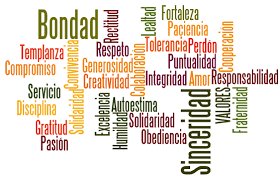















No hay comentarios :
Publicar un comentario